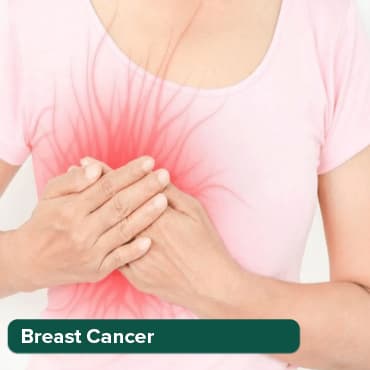
The Different Stages of Breast Cancer: From Diagnosis to Treatment
02 Nov, 2023
 Healthtrip
HealthtripIntroduction
Breast cancer is a complex and challenging disease that affects millions of women and, in rare cases, men worldwide. It is crucial to understand the different stages of breast cancer, as they significantly impact the diagnosis, treatment options, and prognosis for patients. In this blog, we will explore the various stages of breast cancer, from the initial diagnosis to the available treatment options.
Stage 0: Ductal Carcinoma in Situ (DCIS)
Ductal Carcinoma in Situ (DCIS) is the earliest stage of breast cancer. In DCIS, abnormal cells are confined to the milk ducts and have not yet invaded nearby tissues. This stage is considered non-invasive and highly treatable. Often, surgery (lumpectomy or mastectomy) is the primary treatment option, with a high chance of cure.
Transform Your Beauty, Boost Your Confidence
Find the right cosmetic procedure for your needs.

We specialize in a wide range of cosmetic procedures

Stage I: Invasive Ductal Carcinoma (IDC) or Invasive Lobular Carcinoma (ILC)
Stage I breast cancer is characterized by the presence of invasive cancer cells that have begun to invade surrounding breast tissues but are still localized within the breast. It is further divided into two subcategories:
Stage IA
Stage IA breast cancer is characterized by a tumor size of up to 2 centimeters (cm) and no lymph node involvement. Treatment typically involves surgery, such as a lumpectomy or mastectomy, often followed by radiation therapy.
Stage IB
Stage IB breast cancer may have a tumor size of up to 2 cm but may also exhibit small clusters of cancer cells within the lymph nodes near the breast. Treatment often includes surgery and, in some cases, adjuvant therapy, which may involve chemotherapy, hormonal therapy, or targeted therapy.
Stage II: More Extensive Invasive Cancer
Stage II breast cancer is divided into two subcategories:
Stage IIA
Stage IIA breast cancer includes tumors that are either smaller than 2 cm with positive lymph nodes or between 2 cm and 5 cm without lymph node involvement. Treatment typically involves surgery, potentially followed by chemotherapy, hormonal therapy, or targeted therapy.
Stage IIB
Stage IIB breast cancer consists of tumors larger than 5 cm without lymph node involvement or tumors between 2 cm and 5 cm with positive lymph nodes. Treatment may involve a combination of surgery, chemotherapy, hormonal therapy, or targeted therapy, depending on the specific case.
Most popular procedures in
Total Hip Replacemen
Upto 80% off
90% Rated
Satisfactory

Total Hip Replacemen
Upto 80% off
90% Rated
Satisfactory

Breast Cancer Surger
Upto 80% off
90% Rated
Satisfactory

Total Knee Replaceme
Upto 80% off
90% Rated
Satisfactory

Total Knee Replaceme
Upto 80% off
90% Rated
Satisfactory

Stage III: Locally Advanced Breast Cancer
Stage III breast cancer is further divided into three subcategories:
Stage IIIA
Stage IIIA breast cancer may involve larger tumors, extensive lymph node involvement, or both. Treatment usually includes a combination of surgery, chemotherapy, radiation therapy, and hormonal therapy or targeted therapy.
Stage IIIB
Stage IIIB breast cancer indicates cancer that has spread to the chest wall, skin, or nearby lymph nodes, causing noticeable changes such as swelling or ulceration. Treatment is often more aggressive, combining surgery, chemotherapy, radiation therapy, and targeted therapy.
Stage IIIC
Stage IIIC breast cancer has either extensive lymph node involvement or has spread to lymph nodes near the collarbone or internal mammary nodes. Treatment is typically multimodal, with surgery, chemotherapy, radiation therapy, and targeted therapy.
Stage IV: Metastatic Breast Cancer
Stage IV breast cancer, also known as metastatic breast cancer, signifies cancer that has spread to distant parts of the body, such as the lungs, liver, bones, or brain. Treatment focuses on controlling the cancer's growth, alleviating symptoms, and improving the patient's quality of life. Options may include systemic therapies like chemotherapy, hormonal therapy, targeted therapy, and immunotherapy.
Diagnosis and Staging
Diagnosing breast cancer and accurately staging the disease are critical steps in determining the most appropriate treatment plan for a patient. The process involves several key components:
1. Clinical Examination
A clinical breast examination is often the first step in the diagnostic process. During this examination, a healthcare provider assesses the patient's breast tissue for any lumps, changes in texture, or other abnormalities. While clinical exams can raise suspicion, further diagnostic tests are needed to confirm a diagnosis.
2. Imaging Tests
Mammography is a common screening tool for breast cancer. It uses X-rays to create images of the breast tissue. If an abnormality is detected on a mammogram or if a patient has symptoms such as a lump or breast pain, additional imaging tests may be ordered, including:
- Ultrasound: This uses sound waves to create images of the breast and can help determine if a lump is solid or filled with fluid (cyst).
- MRI (Magnetic Resonance Imaging): MRI provides detailed images of the breast and is often used to evaluate the extent of cancer in high-risk patients or those with dense breast tissue.
- Tomosynthesis (3D Mammography): This advanced mammogram technology provides three-dimensional images, which can enhance the detection of breast abnormalities.
3. Biopsy
A biopsy is the definitive method for diagnosing breast cancer. During a biopsy, a sample of the suspicious tissue is removed and examined under a microscope to determine if cancer cells are present. There are different types of breast biopsies, including:
- Fine Needle Aspiration (FNA): A thin, hollow needle is used to remove a small sample of tissue or fluid.
- Core Needle Biopsy: A larger, hollow needle is used to remove a more substantial tissue sample.
- Surgical Biopsy: A surgeon removes a larger portion of the suspicious tissue or the entire lump during a surgical procedure.
4. Staging
Once breast cancer is confirmed, staging is performed to determine the extent and severity of the disease. Staging provides crucial information that guides treatment decisions and helps predict a patient's prognosis. The most commonly used staging system for breast cancer is the TNM (Tumor, Node, Metastasis) system, which includes:
- T (Tumor): Describes the size and extent of the primary tumor.
- N (Node): Indicates the involvement of nearby lymph nodes.
- M (Metastasis): Identifies whether cancer has spread to distant organs.
The American Joint Committee on Cancer (AJCC) provides a comprehensive staging system that further refines these stages, enabling healthcare professionals to make more informed treatment decisions.
Treatment Options
The choice of treatment for breast cancer depends on various factors, including the stage of the disease, the type of breast cancer, the presence of hormone receptors or HER2, and the patient's overall health. Breast cancer treatment is often multidisciplinary, involving a combination of modalities. Here are the primary treatment options:
1. Surgery
Surgery is a common initial treatment for breast cancer and involves the removal of cancerous tissue. The extent of surgery can vary:
- Lumpectomy: Also known as breast-conserving surgery, this procedure removes only the tumor and a margin of surrounding tissue, preserving as much of the breast as possible.
- Mastectomy: A mastectomy involves the removal of the entire breast. There are different types, including simple, modified radical, and skin-sparing mastectomies.
- Sentinel Lymph Node Biopsy: During surgery, nearby lymph nodes are tested to determine if cancer has spread to them. If cancer is found, additional lymph nodes may need to be removed.
2. Radiation Therapy
Radiation therapy uses high-energy X-rays to target and destroy cancer cells or prevent their growth. It is often recommended after a lumpectomy or mastectomy to reduce the risk of cancer recurrence. Radiation therapy is localized and does not affect the entire body.
3. Chemotherapy
Chemotherapy involves the use of drugs to kill cancer cells or stop their growth. It can be administered before surgery (neoadjuvant) to shrink tumors, or after surgery (adjuvant) to prevent recurrence. The specific drugs and regimen depend on the type and stage of breast cancer.
4. Hormone Therapy
Hormone therapy is primarily used for hormone receptor-positive breast cancers. It targets the hormones estrogen and progesterone, which can fuel the growth of these cancers. Common hormone therapy options include:
- Tamoxifen: Blocks estrogen from binding to cancer cells.
- Aromatase Inhibitors: Prevent the body from producing estrogen.
- Ovarian Suppression: Reduces estrogen production in premenopausal women.
5. Targeted Therapy
Targeted therapies are drugs that specifically target the molecular pathways involved in cancer growth. Common targeted therapies include:
- HER2-Targeted Therapies: Used for HER2-positive breast cancers, drugs like trastuzumab (Herceptin) and pertuzumab (Perjeta) inhibit the HER2 protein.
- CDK4/6 Inhibitors: These drugs, such as palbociclib (Ibrance) and ribociclib (Kisqali), are used in combination with hormone therapy for certain cases.
6. Immunotherapy
Immunotherapy is a promising approach that harnesses the body's immune system to target and attack cancer cells. It is still under investigation for breast cancer but has shown potential, particularly in triple-negative breast cancer.
7. Clinical Trials
Clinical trials offer patients access to experimental treatments that may be more effective than standard therapies. These trials help advance the field of breast cancer treatment and provide hope for innovative approaches.
8. Palliative Care
Palliative care focuses on improving the quality of life for patients with advanced or metastatic breast cancer. It addresses symptom management, emotional support, and pain relief to enhance overall well-being.
The choice of treatment and the sequence in which treatments are administered depend on the specific characteristics of the cancer and the patient's individual circumstances. Multidisciplinary teams, including oncologists, surgeons, radiologists, and other specialists, collaborate to create a comprehensive treatment plan tailored to each patient's needs.
In Conclusion
Breast cancer treatment is a dynamic field with a range of options that continue to evolve. Advances in research and personalized medicine have led to more effective and targeted treatments, offering hope for improved outcomes and the better quality of life for breast cancer patients. It is essential for patients to discuss treatment options with their healthcare team to make informed decisions and choose the most suitable approach for their specific diagnosisWellness Treatment
Give yourself the time to relax
Lowest Prices Guaranteed!

Lowest Prices Guaranteed!